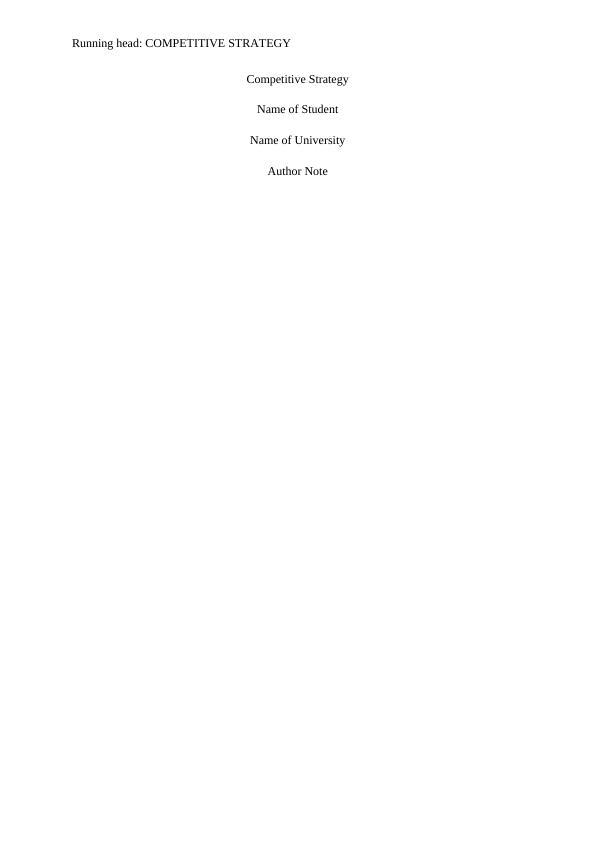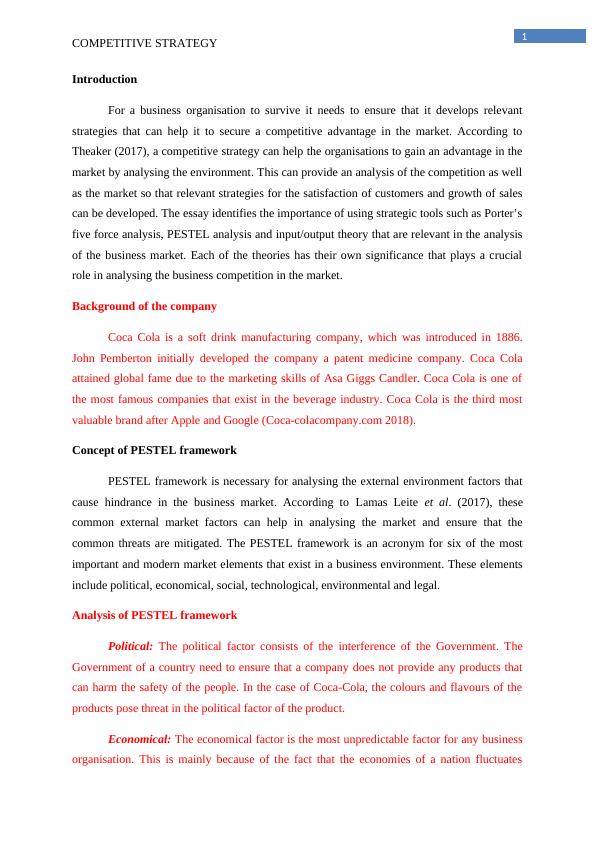Competitive Strategy for Coca Cola: PESTEL, Porter's Five-Force and Input/Output Analysis
Added on 2023-06-14
6 Pages1791 Words480 Views
Running head: COMPETITIVE STRATEGY
Competitive Strategy
Name of Student
Name of University
Author Note
Competitive Strategy
Name of Student
Name of University
Author Note

1
COMPETITIVE STRATEGY
Introduction
For a business organisation to survive it needs to ensure that it develops relevant
strategies that can help it to secure a competitive advantage in the market. According to
Theaker (2017), a competitive strategy can help the organisations to gain an advantage in the
market by analysing the environment. This can provide an analysis of the competition as well
as the market so that relevant strategies for the satisfaction of customers and growth of sales
can be developed. The essay identifies the importance of using strategic tools such as Porter’s
five force analysis, PESTEL analysis and input/output theory that are relevant in the analysis
of the business market. Each of the theories has their own significance that plays a crucial
role in analysing the business competition in the market.
Background of the company
Coca Cola is a soft drink manufacturing company, which was introduced in 1886.
John Pemberton initially developed the company a patent medicine company. Coca Cola
attained global fame due to the marketing skills of Asa Giggs Candler. Coca Cola is one of
the most famous companies that exist in the beverage industry. Coca Cola is the third most
valuable brand after Apple and Google (Coca-colacompany.com 2018).
Concept of PESTEL framework
PESTEL framework is necessary for analysing the external environment factors that
cause hindrance in the business market. According to Lamas Leite et al. (2017), these
common external market factors can help in analysing the market and ensure that the
common threats are mitigated. The PESTEL framework is an acronym for six of the most
important and modern market elements that exist in a business environment. These elements
include political, economical, social, technological, environmental and legal.
Analysis of PESTEL framework
Political: The political factor consists of the interference of the Government. The
Government of a country need to ensure that a company does not provide any products that
can harm the safety of the people. In the case of Coca-Cola, the colours and flavours of the
products pose threat in the political factor of the product.
Economical: The economical factor is the most unpredictable factor for any business
organisation. This is mainly because of the fact that the economies of a nation fluctuates
COMPETITIVE STRATEGY
Introduction
For a business organisation to survive it needs to ensure that it develops relevant
strategies that can help it to secure a competitive advantage in the market. According to
Theaker (2017), a competitive strategy can help the organisations to gain an advantage in the
market by analysing the environment. This can provide an analysis of the competition as well
as the market so that relevant strategies for the satisfaction of customers and growth of sales
can be developed. The essay identifies the importance of using strategic tools such as Porter’s
five force analysis, PESTEL analysis and input/output theory that are relevant in the analysis
of the business market. Each of the theories has their own significance that plays a crucial
role in analysing the business competition in the market.
Background of the company
Coca Cola is a soft drink manufacturing company, which was introduced in 1886.
John Pemberton initially developed the company a patent medicine company. Coca Cola
attained global fame due to the marketing skills of Asa Giggs Candler. Coca Cola is one of
the most famous companies that exist in the beverage industry. Coca Cola is the third most
valuable brand after Apple and Google (Coca-colacompany.com 2018).
Concept of PESTEL framework
PESTEL framework is necessary for analysing the external environment factors that
cause hindrance in the business market. According to Lamas Leite et al. (2017), these
common external market factors can help in analysing the market and ensure that the
common threats are mitigated. The PESTEL framework is an acronym for six of the most
important and modern market elements that exist in a business environment. These elements
include political, economical, social, technological, environmental and legal.
Analysis of PESTEL framework
Political: The political factor consists of the interference of the Government. The
Government of a country need to ensure that a company does not provide any products that
can harm the safety of the people. In the case of Coca-Cola, the colours and flavours of the
products pose threat in the political factor of the product.
Economical: The economical factor is the most unpredictable factor for any business
organisation. This is mainly because of the fact that the economies of a nation fluctuates

2
COMPETITIVE STRATEGY
constantly. Thereby, it is important to conduct an analysis of this factor for the effectiveness
of business.
Social: The use of excess sugar for the manufacturing of the product may cause health
problems people in the society and make people suffer from diseases. Thus, this is considered
as an important health factor to be considered by Coca-Cola.
Technological: The technological advantage that the company can receive is centred
in the manufacturing of the products. The technological advantage received by Coca-Cola is
that the research and development of the company is updated and it helps in identifying any
flaws that may exist in the manufacturing process.
Environmental: According to Rothaermel (2015), conducting a sustainable business
is considered as a major issue in both political as well as environmental form. The
environment of a country need to be protected so that the company and the industry can
prosper under the society.
Legal: A company like Coca-Cola, it needs to ensure that it maintains the rules of the
law and the political government by adhering to the rules set by FDA. The use of plastic
bottles is not always acceptable in many countries because it causes problems in the drainage
of water (Porter and Heppelmann 2014).
Concept of Porter’s five-force framework
According to Dobbs (2014), the external analysis is important for organisations so
that it can analyse the immediate threats that exist in the market. The threats in the markets
are basically the common market and environmental factors that provide resistance to the
service of the organisation. In this regard, one such framework can be used to identify the
threats and competition that exist in a business. Michael Porter identified five forces that may
cause hindrance to the existence of a successful business. The five forces identified by Porter
helps to determine the competitive intensity and the attractiveness that can be gained in terms
of profitability and productivity in an organisation.
Analysis of Porter’s five-force framework
Threat of new entrants: According to Anton (2015), the threat of new entrants is low
for Coca-Cola and of the beverage industry. The reputation of Coca-Cola has made the
COMPETITIVE STRATEGY
constantly. Thereby, it is important to conduct an analysis of this factor for the effectiveness
of business.
Social: The use of excess sugar for the manufacturing of the product may cause health
problems people in the society and make people suffer from diseases. Thus, this is considered
as an important health factor to be considered by Coca-Cola.
Technological: The technological advantage that the company can receive is centred
in the manufacturing of the products. The technological advantage received by Coca-Cola is
that the research and development of the company is updated and it helps in identifying any
flaws that may exist in the manufacturing process.
Environmental: According to Rothaermel (2015), conducting a sustainable business
is considered as a major issue in both political as well as environmental form. The
environment of a country need to be protected so that the company and the industry can
prosper under the society.
Legal: A company like Coca-Cola, it needs to ensure that it maintains the rules of the
law and the political government by adhering to the rules set by FDA. The use of plastic
bottles is not always acceptable in many countries because it causes problems in the drainage
of water (Porter and Heppelmann 2014).
Concept of Porter’s five-force framework
According to Dobbs (2014), the external analysis is important for organisations so
that it can analyse the immediate threats that exist in the market. The threats in the markets
are basically the common market and environmental factors that provide resistance to the
service of the organisation. In this regard, one such framework can be used to identify the
threats and competition that exist in a business. Michael Porter identified five forces that may
cause hindrance to the existence of a successful business. The five forces identified by Porter
helps to determine the competitive intensity and the attractiveness that can be gained in terms
of profitability and productivity in an organisation.
Analysis of Porter’s five-force framework
Threat of new entrants: According to Anton (2015), the threat of new entrants is low
for Coca-Cola and of the beverage industry. The reputation of Coca-Cola has made the

End of preview
Want to access all the pages? Upload your documents or become a member.
Related Documents
Case Study Analysis of PepsiColg...
|5
|847
|364
PESTLE Analysis of Coca-Cola and Demographic Segmentationlg...
|8
|852
|81
Coca Cola Brand Extensionlg...
|13
|758
|58
Marketing Plan Coca Cola - Assignmentlg...
|25
|7962
|100
Strategic Management: Analysis of Coca-Cola's International Strategy and IMI's Business Strategylg...
|16
|4579
|343
Coca Cola Marketing Managementlg...
|14
|1139
|250
